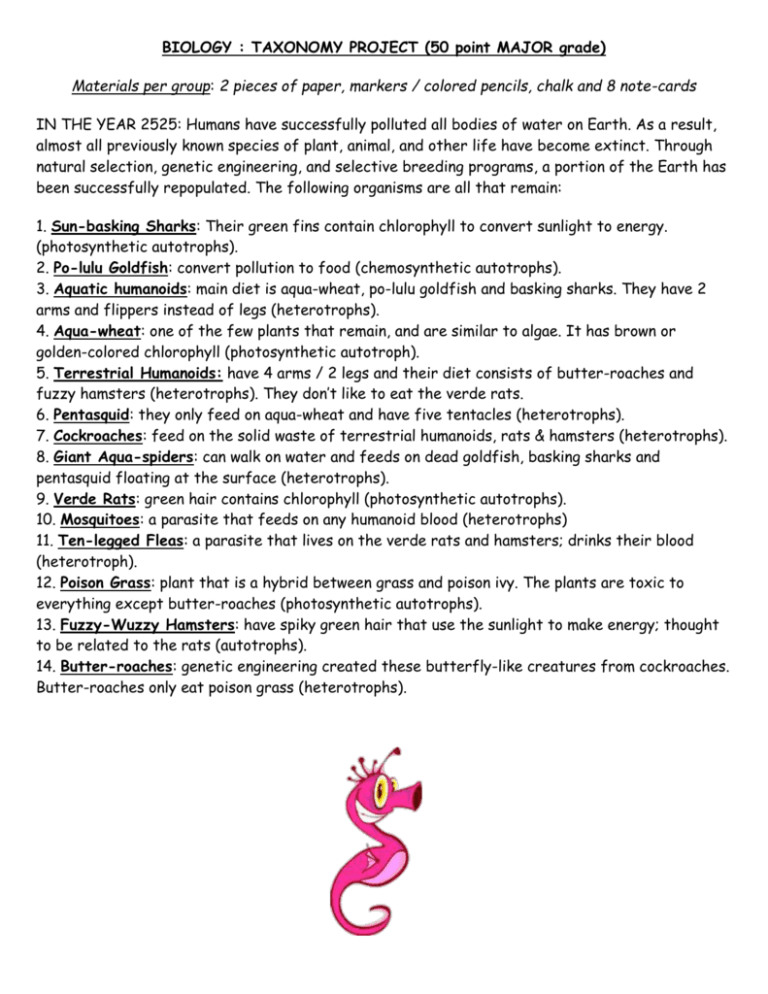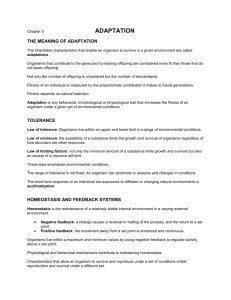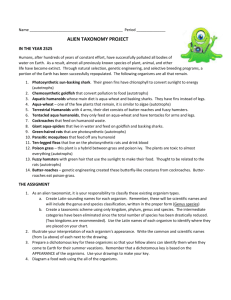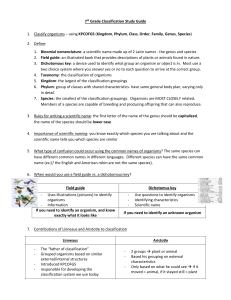Taxonomy Project
advertisement

BIOLOGY : TAXONOMY PROJECT (50 point MAJOR grade) Materials per group: 2 pieces of paper, markers / colored pencils, chalk and 8 note-cards IN THE YEAR 2525: Humans have successfully polluted all bodies of water on Earth. As a result, almost all previously known species of plant, animal, and other life have become extinct. Through natural selection, genetic engineering, and selective breeding programs, a portion of the Earth has been successfully repopulated. The following organisms are all that remain: 1. Sun-basking Sharks: Their green fins contain chlorophyll to convert sunlight to energy. (photosynthetic autotrophs). 2. Po-lulu Goldfish: convert pollution to food (chemosynthetic autotrophs). 3. Aquatic humanoids: main diet is aqua-wheat, po-lulu goldfish and basking sharks. They have 2 arms and flippers instead of legs (heterotrophs). 4. Aqua-wheat: one of the few plants that remain, and are similar to algae. It has brown or golden-colored chlorophyll (photosynthetic autotroph). 5. Terrestrial Humanoids: have 4 arms / 2 legs and their diet consists of butter-roaches and fuzzy hamsters (heterotrophs). They don’t like to eat the verde rats. 6. Pentasquid: they only feed on aqua-wheat and have five tentacles (heterotrophs). 7. Cockroaches: feed on the solid waste of terrestrial humanoids, rats & hamsters (heterotrophs). 8. Giant Aqua-spiders: can walk on water and feeds on dead goldfish, basking sharks and pentasquid floating at the surface (heterotrophs). 9. Verde Rats: green hair contains chlorophyll (photosynthetic autotrophs). 10. Mosquitoes: a parasite that feeds on any humanoid blood (heterotrophs) 11. Ten-legged Fleas: a parasite that lives on the verde rats and hamsters; drinks their blood (heterotroph). 12. Poison Grass: plant that is a hybrid between grass and poison ivy. The plants are toxic to everything except butter-roaches (photosynthetic autotrophs). 13. Fuzzy-Wuzzy Hamsters: have spiky green hair that use the sunlight to make energy; thought to be related to the rats (autotrophs). 14. Butter-roaches: genetic engineering created these butterfly-like creatures from cockroaches. Butter-roaches only eat poison grass (heterotrophs). YOUR ASSIGNMENT Step 1: Illustrate your interpretation of each organism's appearance on a note card. (ONE organism per note card.) You only have to choose 8 from the list above. a. b. c. d. Top left corner place the NUMBER of the organism (see list above). Top right corner indicate whether the organism is an autotroph or heterotroph. Bottom left corner write the COMMON NAME (see list above). Bottom right corner write the SCIENTIFIC NAME (not until Step #3). EXAMPLE: #1 autotroph Put drawing here … Common Name Scientific Name Step2: As an Alien taxonomist, it is your responsibility to classify these existing organisms. On your own piece of paper, create a taxonomic scheme using only kingdom, phylum, genus, and species. The intermediate categories have been eliminated since the total number of species has been drastically reduced. Use the NUMBER of each organism when placing them on your chart. a. Kingdom: divide the organisms into two groups. Name the groups. b. Phylum: take the first Kingdom and divide it into two more groups. Name these 2 new groups. Take the second Kingdom and divide it into two groups. Name these 2 new groups. You should have 4 phyla. c. Genus: further divide the phyla. You should have 8 genus groups. d. Species: only one organism per species group. This is now where you will nameyour organisms scientifically. Step 3: Using binomial nomenclature, create a LATIN “SOUNDING” name for each organism. Write the name you create underneath the picture on your note card. Remember, these are scientific names and you MUST USE THE GENUS and SPECIES of your classification system created in Step #2. (Example: Sun-Basking Shark = Sunnus baskus) Step 4: Prepare a dichotomous key for these organisms so that your fellow scientists can identify the organisms when they come to Earth. Remember that a dichotomous key is based on APPEARANCE of the organisms. Use your drawings to make the dichotomous key on your own piece of paper. TAXONOMY PROJECT RUBRIC Table Number: ______________________ Class Period: _______ ASSIGNMENT 1. 8 Drawings 2. 8 Scientific names 3. Classification chart (on your own paper) 4. Dichotomous Key (on your own paper) 5. Creativity and Neatness Total: Total Possible POINTS 10 10 10 15 5 50 Points EARNED Example of Example of Final Product for Taxonomy Project: I have an example in class to look at Dichotomous Key: 1. a. The organism is red … go to 2 b. The organism is blue .. go to 3 2. a. The organism is …. go to 4 b. The organism is …. Organism's name Final Product should be a paper with 8 notecards of organisms, dichotomous key and classication system. Classication System: Kingdom A Phylum A Phylum B Kingdom B Phylum C Phylum D GenusA GenusB GenusC GenusD GenusA GenusB GenusC GenusD Species Species Species Species Species Species Species Species









